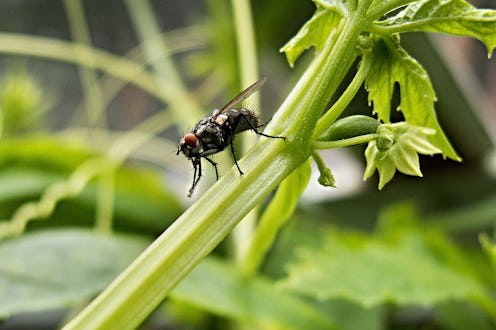If you're eating, and a fly lands on your food, you likely swat the pest away and continue with your meal. I'd like to apologize up front for ruining your future meals because what really happens when a fly lands on your food is actually pretty disgusting. Flies are everywhere, especially in the summer, so keeping your meal fly free might feel impossible.
I was in Joshua Tree recently, and thanks to a very wet winter, the whole town was swarming with flies like some kind of end-of-days plague. Every meal I had was accompanied by dozens of flies buzzing near my pizza, my eggs, and my cocktails. During one dinner I had to wrap my shirt around my head just to keep them off of my face. After learning what those flies were really doing while they were dive bombing my burger, I feel a little sick.
These little buggers carry more than 200 different types of bacteria. "Flies can carry cholera, typhoid and dysentery, and they are actually twice as germ-ridden as cockroaches," Francis Horton noted on Health Guidance.
One study, according to USA Today, reported that flies carry these diseases on their legs and the small hairs that cover their bodies. When they stand on your food they leave little presents behind.
The Ick Factor
Flies are quick and crafty, and they can ruin your meal faster than you can swat them away.
"It takes only a matter of seconds for them to transfer these pathogens to food or touched surfaces," USA Today reported. What's more is that the symptoms of being exposed can mimic food poisoning. If a fly leaves something behind on your plate you might experience diarrhea, nausea, vomiting, fever, headaches, and lethargy.
Because they can't chew, flies vomit digestive enzymes onto your food before they slurp it back up again. And, flies lay eggs, which turn into maggots. While you might be throwing up a little bit in your mouth right now, there is actually a cheese that is eaten with live maggots as part of the experience. And, no, it's not some kind of crazy Real World/Road Rules Challenge contest. People do this voluntarily.
According to CNN, celebrity chef Gordon Ramsay called Casu Marzu "the most dangerous cheese in the world." The cheese is made when pecorino cheese is left it to rot and attract flies. Once the flies lay their eggs, and they hatch into maggots, the cheese becomes Casu Marzu. Can I interest you in a cheese plate? No, you're not hungry anymore? I'm with you on this one, because, maggots!
And, can we talk about what the flies are doing before they land on your plate? Flies are notorious scavengers. These insects get their kicks by eating rotting, rancid, decaying corpses and garbage. They hang around in pools of stagnant water where they get all gross and dirty. Then, without washing the 200-plus germs off of their little hairy legs, they come and visit your food.
According to the Smithsonian, flies do serve a purpose, just not one related to your food. "Flies that visit flowers are helpful in the pollination of flowering plants. The maggots of hover flies are welcomed by gardeners because they feed on aphids, reducing numbers of those pests. Many flies are parasitic, feeding on moth caterpillars, beetle grubs, and other pest species."
Because most people aren't aware of the true ick factor of flies, in one survey conducted by pest-control company Orkin, 61 percent said a cockroach would make them put their fork down, but only 3 percent of diners said the presence of a fly on their food would cause them to stop eating. Well, roaches are horrible, germ carrying menaces, right? While this is true, remember that flies are twice as likely to spread germs as cockroaches.
How about we just agree that all bugs are gross, and if there is any kind of insect moving on your dinner plate it's probably best to throw that meal in the trash.
